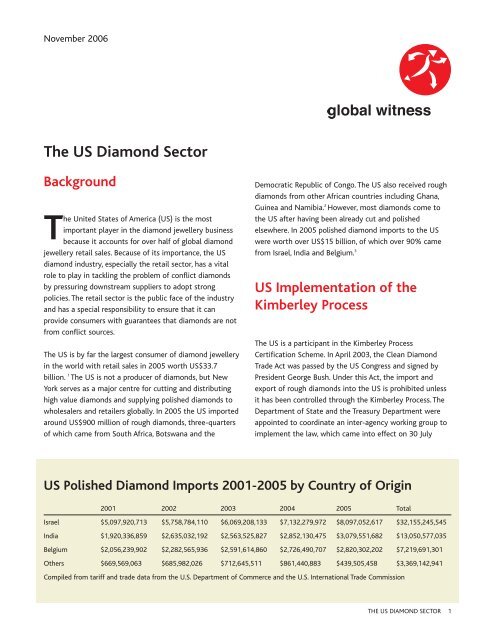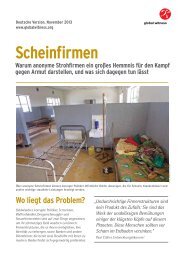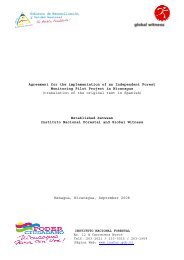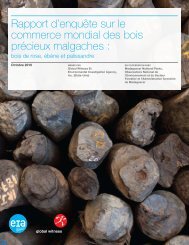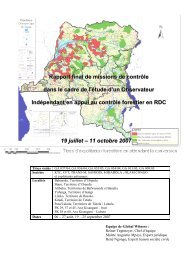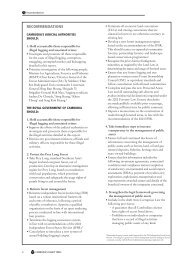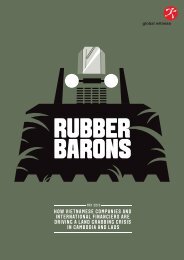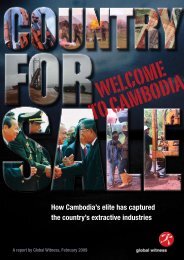The US Diamond Sector - Global Witness
The US Diamond Sector - Global Witness
The US Diamond Sector - Global Witness
You also want an ePaper? Increase the reach of your titles
YUMPU automatically turns print PDFs into web optimized ePapers that Google loves.
November 2006<br />
<strong>The</strong> <strong>US</strong> <strong>Diamond</strong> <strong>Sector</strong><br />
Background<br />
<strong>The</strong> United States of America (<strong>US</strong>) is the most<br />
important player in the diamond jewellery business<br />
because it accounts for over half of global diamond<br />
jewellery retail sales. Because of its importance, the <strong>US</strong><br />
diamond industry, especially the retail sector, has a vital<br />
role to play in tackling the problem of conflict diamonds<br />
by pressuring downstream suppliers to adopt strong<br />
policies. <strong>The</strong> retail sector is the public face of the industry<br />
and has a special responsibility to ensure that it can<br />
provide consumers with guarantees that diamonds are not<br />
from conflict sources.<br />
<strong>The</strong> <strong>US</strong> is by far the largest consumer of diamond jewellery<br />
in the world with retail sales in 2005 worth <strong>US</strong>$33.7<br />
billion. 1 <strong>The</strong> <strong>US</strong> is not a producer of diamonds, but New<br />
York serves as a major centre for cutting and distributing<br />
high value diamonds and supplying polished diamonds to<br />
wholesalers and retailers globally. In 2005 the <strong>US</strong> imported<br />
around <strong>US</strong>$900 million of rough diamonds, three-quarters<br />
of which came from South Africa, Botswana and the<br />
Democratic Republic of Congo. <strong>The</strong> <strong>US</strong> also received rough<br />
diamonds from other African countries including Ghana,<br />
Guinea and Namibia. 2 However, most diamonds come to<br />
the <strong>US</strong> after having been already cut and polished<br />
elsewhere. In 2005 polished diamond imports to the <strong>US</strong><br />
were worth over <strong>US</strong>$15 billion, of which over 90% came<br />
from Israel, India and Belgium. 3<br />
<strong>US</strong> Implementation of the<br />
Kimberley Process<br />
<strong>The</strong> <strong>US</strong> is a participant in the Kimberley Process<br />
Certification Scheme. In April 2003, the Clean <strong>Diamond</strong><br />
Trade Act was passed by the <strong>US</strong> Congress and signed by<br />
President George Bush. Under this Act, the import and<br />
export of rough diamonds into the <strong>US</strong> is prohibited unless<br />
it has been controlled through the Kimberley Process. <strong>The</strong><br />
Department of State and the Treasury Department were<br />
appointed to coordinate an inter-agency working group to<br />
implement the law, which came into effect on 30 July<br />
<strong>US</strong> Polished <strong>Diamond</strong> Imports 2001-2005 by Country of Origin<br />
2001 2002 2003 2004 2005 Total<br />
Israel $5,097,920,713 $5,758,784,110 $6,069,208,133 $7,132,279,972 $8,097,052,617 $32,155,245,545<br />
India $1,920,336,859 $2,635,032,192 $2,563,525,827 $2,852,130,475 $3,079,551,682 $13,050,577,035<br />
Belgium $2,056,239,902 $2,282,565,936 $2,591,614,860 $2,726,490,707 $2,820,302,202 $7,219,691,301<br />
Others $669,569,063 $685,982,026 $712,645,511 $861,440,883 $439,505,458 $3,369,142,941<br />
Compiled from tariff and trade data from the U.S. Department of Commerce and the U.S. International Trade Commission<br />
THE <strong>US</strong> DIAMOND SECTOR 1
2003. 5 Those who are found in violation of the Act’s<br />
requirements face civil and criminal penalties that include<br />
fines and imprisonment of up to 10 years. 6<br />
<strong>The</strong> <strong>US</strong> Kimberley Process Authority was set up and run by<br />
officials from <strong>US</strong> trade associations, including the <strong>Diamond</strong><br />
Dealers Club and the Jewelers Vigilance Committee. It is<br />
responsible for facilitating the issuance of the Kimberley<br />
Process certificates for exports of rough diamonds and<br />
reporting this to the <strong>US</strong> government. All exporters of rough<br />
diamonds are required to file export information through<br />
the <strong>US</strong> Census Bureau’s Automated Export System, which is<br />
then validated by the government through the issuance of<br />
an Internal Transaction Number. 7<br />
<strong>The</strong> <strong>US</strong> Customs and Border Protection is the government<br />
agency responsible for enforcing the import provisions of<br />
the Clean <strong>Diamond</strong> Trade Act. Importers of rough diamonds<br />
are required to file electronically, including by providing<br />
information about the Kimberley Process certificate, which<br />
is then reviewed by the <strong>US</strong> Customs and Border Protection.<br />
Physical inspection of imports and exports has been very<br />
limited, mainly relying on risk analysis.<br />
Serious Loopholes in <strong>US</strong><br />
<strong>Diamond</strong> Law<br />
A recent Government Accountability Office (GAO) report<br />
shows that conflict diamonds may be entering the <strong>US</strong><br />
because of major weaknesses in the implementation of<br />
the Clean <strong>Diamond</strong> Trade Act, the <strong>US</strong> law which<br />
implements the Kimberley Process Certification Scheme<br />
(KPCS). <strong>The</strong> GAO report states that “because of<br />
weaknesses of the system, the United States cannot<br />
ensure that illicit rough diamonds are not traded.” <strong>The</strong>se<br />
weaknesses include a lack of regular physical inspections<br />
of rough diamond imports and exports, poor statistics on<br />
rough diamonds and no plan for monitoring the Kimberley<br />
Process Authority, a private entity run by <strong>US</strong> diamond<br />
trade groups which issues rough diamond certificates. A<br />
multi-stakeholder peer review carried out by the<br />
Kimberley Process in June 2005 and earlier studies done<br />
by <strong>Global</strong> <strong>Witness</strong> and Partnership Africa Canada also<br />
identified similar problems. 8<br />
If the <strong>US</strong> diamond sector is to have any credibility,<br />
government oversight of industry must improve. <strong>The</strong> <strong>US</strong>,<br />
as the largest consumer of diamond jewellery, has a<br />
responsibility to play a leadership role on this issue and to<br />
have a robust system of controls in place.<br />
Anti-Money Laundering Rules<br />
Anti-money laundering requirements are another<br />
requirement the <strong>US</strong> diamond industry must comply with.<br />
Under the Patriot Act, dealers and traders in precious<br />
metals, stones and jewels are now considered reporting<br />
entities in the <strong>US</strong> and must have put anti-money laundering<br />
measures in place by January 1st 2006.With some<br />
exceptions, the rules set by the <strong>US</strong> Treasury relate to any<br />
dealer or trader who buys or sells more than <strong>US</strong>$50,000<br />
worth of goods which derive more than 50% of their value<br />
from precious metals, stones and jewels. 9 Dealers and<br />
traders are required to: perform an assessment of the<br />
company’s risk to money laundering, appoint a compliance<br />
officer for anti-money laundering, design and implement an<br />
anti-money laundering program, train employees and test<br />
the money laundering program periodically. 10<br />
<strong>US</strong> Polished <strong>Diamond</strong> Imports by Country<br />
2001-2005<strong>US</strong>$<br />
Belgium 13%<br />
India 23%<br />
Others 9%<br />
<strong>Global</strong> Retail Sales of <strong>Diamond</strong> Jewelry 2005<br />
(<strong>US</strong>$billion)<br />
Asia Middle East 7%<br />
Asia Pacific 6%<br />
Japan 16%<br />
Others 8%<br />
Europe and<br />
South Africa 13%<br />
Israel 55%<br />
Americas 55%<br />
Source: http://www.idexonline.com/pdf_files/IDEX_Online-<br />
2005_Pipeline.pdf<br />
THE <strong>US</strong> DIAMOND SECTOR 2
<strong>The</strong> Patriot Act has huge implications for the diamond<br />
jewellery industry, an industry that has traditionally been<br />
extremely secretive and prefers to use cash. While recognizing<br />
the civil liberty concerns with the Patriot Act, <strong>Global</strong> <strong>Witness</strong><br />
believes that the anti-money laundering sections could have<br />
a powerful effect on cracking down on the use of diamonds<br />
for illicit purposes and for conflict and terrorism. However,<br />
the success of these rules depends on widespread compliance<br />
by the diamond industry and effective enforcement of these<br />
provisions by the Treasury Department.<br />
<strong>The</strong> <strong>Diamond</strong> Industry’s Broken<br />
Promises<br />
<strong>The</strong>re are several major trade bodies located in the <strong>US</strong> that<br />
have represented the diamond industry on the issue of<br />
conflict diamonds. <strong>The</strong>se include the World <strong>Diamond</strong><br />
Council, which was created to represent all sectors of the<br />
diamond trade on the conflict diamond issue and at the<br />
Kimberley Process meetings, Jewelers of America and the<br />
Jewelers Vigilance Committee. 11 <strong>The</strong> Gemological Institute<br />
of America is based in California and certifies diamonds for<br />
quality, but does not certify diamonds for conflict-free<br />
status. Other major diamond trade bodies include the New<br />
York <strong>Diamond</strong> Dealers Club, the International <strong>Diamond</strong><br />
Manufacturers Association (IDMA), the World Federation of<br />
<strong>Diamond</strong> Bourses (WFDB) and the World Jewelry<br />
Confederation (CIBJO).<br />
<strong>The</strong> <strong>US</strong> and other international diamond industry bodies<br />
have made many promises in support of the Kimberley<br />
Process including implementing a system of selfregulation<br />
to support a chain of custody from mine to<br />
shop front. However, the diamond industry has not kept<br />
many of these promises.<br />
Some of these trade bodies have produced educational<br />
materials to educate the industry about the Kimberley<br />
Process. For example, in 2003 the WDC produced <strong>The</strong><br />
Essential Guide to the Kimberley Process to inform sectors of<br />
the industry how to carry out the self-regulation. In 2005,<br />
the Jewelers Vigilance Committee issued an Anti- Money<br />
Laundering Compliance Kit to help companies comply with<br />
the Patriot Act anti-money laundering regulations that<br />
have recently come into effect in the <strong>US</strong>. A new World<br />
©<strong>Global</strong> <strong>Witness</strong><br />
Most diamonds that arrive in the <strong>US</strong> are polished overseas in factories.<br />
THE <strong>US</strong> DIAMOND SECTOR 3
<strong>Diamond</strong> Council website provides education packs for<br />
consumers and retailers.<br />
However, little has been done to go beyond these efforts<br />
to actively promote adoption of the self-regulation. In<br />
addition, trade bodies have done inadequate monitoring to<br />
ensure that the self-regulation is being implemented by<br />
their members. Instead of focusing on solving the problem,<br />
the diamond industry has launched an aggressive public<br />
relations campaign vastly overstating the progress made<br />
and falsely claiming that conflict diamonds are not a<br />
significant problem.<br />
<strong>Global</strong> <strong>Witness</strong> has also carried out investigations showing<br />
that the <strong>US</strong> diamond jewellery retail sector has failed to<br />
follow through on commitments to combat conflict<br />
diamonds and cannot give consumers adequate assurances<br />
that diamonds are conflict free. In 2004, using secret<br />
cameras, <strong>Global</strong> <strong>Witness</strong> went to several <strong>US</strong> stores to ask<br />
them about their policies on conflict diamonds. <strong>The</strong> retail<br />
sector was chosen because it is the public face of the<br />
industry and has a special responsibility to ensure that it<br />
can provide consumers with guarantees that diamonds are<br />
not from conflict sources. We found that most stores had<br />
no policy in place, or had not put basic measures of the<br />
self regulation into place. 12 A larger Amnesty International<br />
and <strong>Global</strong> <strong>Witness</strong> survey published in October 2004 built<br />
on this work, and found that across the <strong>US</strong>, there was a<br />
very low level of awareness about conflict diamonds by<br />
sales assistants and only 27% of stores visited stated that<br />
they had a policy on conflict diamonds. 13<br />
On Valentines Day 2006 <strong>Global</strong> <strong>Witness</strong> and Amnesty<br />
International produced a short guide on conflict diamonds<br />
for consumers in the <strong>US</strong> and globally. <strong>The</strong> guide tells<br />
shoppers what they need to know about the trade in<br />
conflict diamonds and the questions they need to ask<br />
jewellery retailers to try and ensure the diamonds they buy<br />
are conflict-free. 14<br />
References<br />
1 National Jeweler, DIC: U.S. diamond retail sales up 7 percent, 3 May 2006.<br />
2 United States International Trade Commission http://dataweb.usitc.gov/<br />
3 United States International Trade Commission http://dataweb.usitc.gov/<br />
4 ‘Rough <strong>Diamond</strong>s Control Regulations’, Federal Register, 4 August 2003, Vol. 68, No. 149.<br />
5 Executive Order Implementing the Clean <strong>Diamond</strong> Trade Act, July 29, 2003, President George Bush, <strong>The</strong> White House.<br />
6 Clean <strong>Diamond</strong> Trade Act, Section 8, Enforcement, 108th Congress, April 2003.<br />
7 ‘Rough <strong>Diamond</strong>s Control Regulations’, Federal Register, 4 August 2003, Vol. 68, No. 149.<br />
8 See GAO report, Agency Actions Needed to Enhance Implementation of the Clean <strong>Diamond</strong> Trade Act, September 2006.<br />
http://www.gao.gov/new.items/d06978.pdf<br />
9 http://www.fincen.gov/antimoneylaundering060305.pdf<br />
10 http://www.jvclegal.org/t_r_pack_summary.html<br />
11 Jewelers of America and the Jewelers Vigilance Committee are two major <strong>US</strong> jewelry trade organizations that have<br />
endorsed the self-regulation and have carried out some educational activities for its members about the Kimberley<br />
Process and the self-regulation.<br />
12 <strong>Global</strong> <strong>Witness</strong> Broken Vows: Exposing the “Loupe” holes in the <strong>Diamond</strong> Industry’s Efforts to Prevent the Trade in Conflict<br />
<strong>Diamond</strong>s, March 2004. http://www.globalwitness.org/reports/show.php/en.00050.html<br />
13 Amnesty International and <strong>Global</strong> <strong>Witness</strong> Déjà vu: diamond industry still failing to deliver on promises October 2004<br />
http://www.globalwitness.org/reports/show.php/en.00062.html<br />
14 http://www.globalwitness.org/buy/conflictfree><br />
© <strong>Global</strong> <strong>Witness</strong> Publishing Inc.<br />
<strong>Global</strong> <strong>Witness</strong> is British-based non-governmental organisation which investigates the role of natural resources in funding conflict and corruption around the world. References to ‘<strong>Global</strong><br />
<strong>Witness</strong>’ above and in the body of this report are to <strong>Global</strong> <strong>Witness</strong> Limited, a company limited by guarantees and registered in England and Wales. This Report is compiled, published and<br />
distributed by <strong>Global</strong> <strong>Witness</strong> Publishing Inc. from the results of research and investigations carried out by <strong>Global</strong> <strong>Witness</strong> Limited and is used to brief governments, inter-governmental<br />
organisations, civil society, the media and the public.<br />
www.globalwitness.org<br />
THE <strong>US</strong> DIAMOND SECTOR 4


